I’ve tested, examined, and assessed the most well-liked drag-and-drop app builders as a software developer in order to narrow down the top solutions for streamlining the app creation process.
It can be difficult to choose the best drag-and-drop app builder for you when there are so many options available. It’s clear that you want to speed up the app development process, but you still need to choose the right tool for the job. You’re in my hands! With my selections of the top drag-and-drop app builders, I’ll make your decision easier in this post by sharing my personal experiences with dozens of different drag-and-drop app builders with large teams and projects.
Why Count on Our Reviews of Drag-and-Drop App Builders ?
Since 2020, we have been evaluating and testing drag-and-drop app builders. Since we are developers, we are aware of how important and challenging it may be to choose the proper software.
To assist our audience in making more informed software purchases, we fund extensive research. We’ve authored over 1,000 in-depth product reviews and tested over 2,000 tools for various software development use cases.
How to Pick an App Builder That Drags and Drops ?
When you’re narrowing down, testing, and choosing drag-and-drop app builders, keep the following in mind:
What issue are you trying to solve? To determine what features and capabilities the tool needs to offer, start by determining the feature gap in app construction that you’re seeking to address.
Who is going to need to use it? Take into account who will use the platform and how many licenses you’ll need while evaluating costs and needs. You’ll need to determine whether access is needed for the entire organization or just the product development team. Once that’s evident, you should think about whether you’re more interested in making things simple for everyone or fast for your tech-savvy people.
Additional tools required for its operation – Make it clear which tools you’re keeping, which ones you’re replacing, and which ones you’ll need to integrate with. This might comprise your entire tech stack, different data sources, and your current infrastructure for developing apps. Additionally, you may need to determine whether the tools must work together or if you may use a single drag-and-drop app builder to replace several different tools.
Which results matter? Think about the outcome that the tool must produce in order to be deemed successful. Consider the skills you wish to acquire, the things you wish to get better at, and the metrics you will use to determine success. You might compare drag-and-drop app builder features endlessly, but you might be squandering a lot of valuable time if you’re not considering the results you want to achieve.
How it would function in your company: Take into account the solutions in conjunction with your delivery methods and workflows. Examine the things that are doing well and the areas that want attention that are producing problems. Keep in mind that every company is unique, so don’t assume that just because a tool is well-liked, it will function well for you too.
Bubble

With the help of the platform Bubble, anyone can create, develop, and launch online apps without having to know how to code. It is a great option for anyone who want to create complex web apps but lack the experience with traditional programming because of its visual development interface and strong back-end features.
Why I Selected Bubble
Bubble’s remarkable no-code capabilities drew my notice when choosing the tools for this list. I evaluated it against other platforms to assess its potential and came to the conclusion that its distinct combination of strong logic tools and beautiful design makes it stand out. I believe it to be the ideal option for this particular use case because it simplifies the process of creating web apps without requiring coding knowledge.
Key Features & Integrations:
A drag-and-drop builder provided by Bubble makes it simple to create user interfaces visually. Additionally, it has an integrated database that makes data management simple for users. Regarding integrations, Bubble boasts a plugin system that establishes connections with numerous services, such as Stripe, Google Maps, and multiple authentication providers, among others.
| Pros | Cons |
| Wide selection of plugins to improve the functioning of apps | The basic package does not include a custom domain |
| Data management is facilitated by built-in database capability | Certain advanced features may require more expensive plans |
| Design is made easier by an intuitive drag-and-drop interface | Perhaps a learning curve for those who are not experienced |
Zoho Creator

A cloud-based platform called Zoho Creator is designed to assist companies in developing unique applications that optimize particular processes. Because of its emphasis on business processes, it’s especially beneficial for businesses trying to create apps that meet specific operational needs.
The Reason I Selected Zoho Creator:
Because of its focus on business process apps, Zoho Creator has often drawn my attention during my research into app development platforms. The platform was unique because it could adapt to the specific needs of different types of enterprises. I concluded that Zoho Creator is the best option for businesses looking to develop apps that are in line with their unique workflows.
Key Features & Integrations:
With features like drag-and-drop customization made simple, Zoho Creator ensures that businesses can develop their iOS or Android apps without requiring technical knowledge. The program also has strong automation features that increase the productivity of repetitive activities. In terms of integrations, Zoho Creator extends its capability by integrating seamlessly through APIs with major third-party applications and other Zoho Suite products.
| Pros | Cons |
| Complete connectivity with third-party apps and Zoho Suite | A few users mention sporadic software errors |
| Strong automation tools to simplify work-related activities | Perhaps unable to meet demands for enhanced growth |
| Capabilities for intuitive design without requiring coding | More difficult learning curve for people who are not familiar with Zoho products |
AppMachine

A technology called AppMachine makes it easier to create native mobile apps without the requirement for coding knowledge. It enables companies, consumers, and developers to produce apps of a high caliber without being constrained by the complexities of programming.
Why AppMachine was my choice:
I constantly evaluated tools according to their USPs and user reviews before choosing them for inclusion. Because of its user-friendly interface and promise of code-free native app production, AppMachine stood out. I found that, considering its capabilities, it was the perfect choice for anyone who wanted native apps without having to bother with coding.
Key Features & Integrations:
With its drag-and-drop interface, AppMachine makes app creation easier and more accessible for a larger user base. Many pre-designed templates are available to help customers get started on their projects right away. The platform enhances user experience by integrating with several third-party services, such as YouTube, Facebook, and Google Maps.
| Pros | Cons |
| Strong third-party integrations to increase the functionality of the app | The learning curve for total novices |
| A range of templates designed to meet different business requirements | Internet access is necessary in order to build apps |
| A drag-and-drop interface that is easy to use | More sophisticated adjustments may be restrictive to some users |
AppInstitute

AppInstitute offers a platform for developing mobile applications to organizations, particularly small and medium-sized ones. AppInstitute is a crucial resource for SMBs looking to carve out a mobile specialty, given the growing trend of business involvement through mobile devices.
Why AppInstitute was my choice:
AppInstitute was the clear winner in my search for the best app builders for various purposes, especially for smaller companies. Its specialized approach to serving SMBs set it apart from other platforms and gave companies of all sizes a competitive advantage in the mobile market. I came to the conclusion that AppInstitute is unquestionably a great choice for SMBs looking to establish a strong mobile presence.
Key Features & Integrations:
AppInstitute boasts features like customizable templates suited for different company sectors and an intuitive drag-and-drop app builder software that streamline the app development process. Furthermore, the platform easily interacts with well-known CRM programs and e-commerce platforms, streamlining and strengthening corporate processes.
| Pros | Cons |
| Good compatibility with CRM and e-commerce systems | Regular users might need to reacquaint themselves with platform updates |
| Industry-specific templates address a range of business requirements | Restricted advanced personalization in comparison to certain rivals |
| Simple drag-and-drop interface that’s ideal for novices | Perhaps too expensive for extremely small companies or startups |
Appy Pie
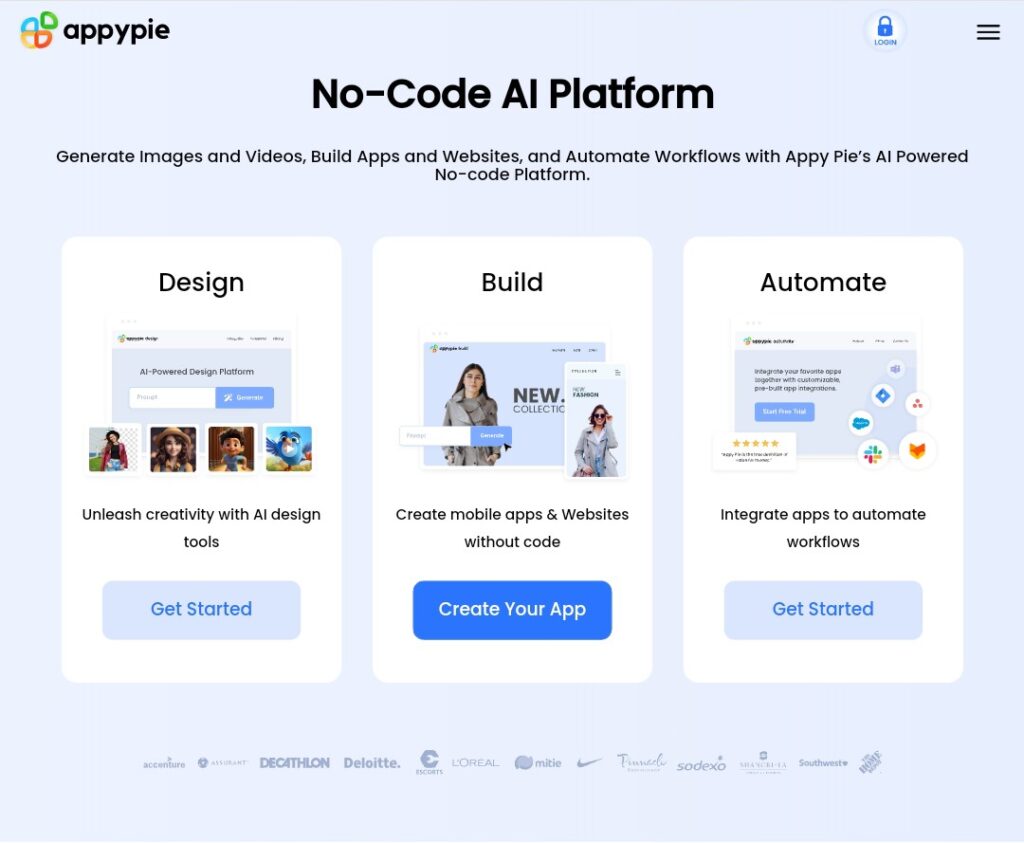
With the help of Appy Pie, novices may confidently take their first steps into the world of app creation. Its user-friendly design tools and easy layout make it an excellent option for beginners, which is in line with its reputation for being welcoming to individuals who are new to creating apps.
Why Appy Pie was my choice:
Appy Pie’s unique simplicity and approachability—especially in comparison to other platforms—were the main reasons I chose it. In my comparative analysis, I discovered that its UI was the most user-friendly for beginners. When it comes to helping beginners get started with app creation, this tool truly shines, making sure they don’t feel overwhelmed.
Key Features & Integrations:
With the use of Appy Pie’s no-code platform, users can create apps without having to learn the complexities of coding. Its extensive template collection allows customers to select from a wide range of designs catered to various sectors. Regarding integration, Appy Pie works effectively with a variety of outside tools, including CRM systems, e-commerce platforms, and social media sites.
| Pros | Cons |
| Simplified interaction with widely used third-party applications | Pricing for smaller jobs may be a little more than average |
| A large selection of design templates for many industries | Templates might be restrictive for original design concepts |
| An intuitive UI that is perfect for novices | Possibly lacking sophisticated features for experienced developers |
GoodBarber
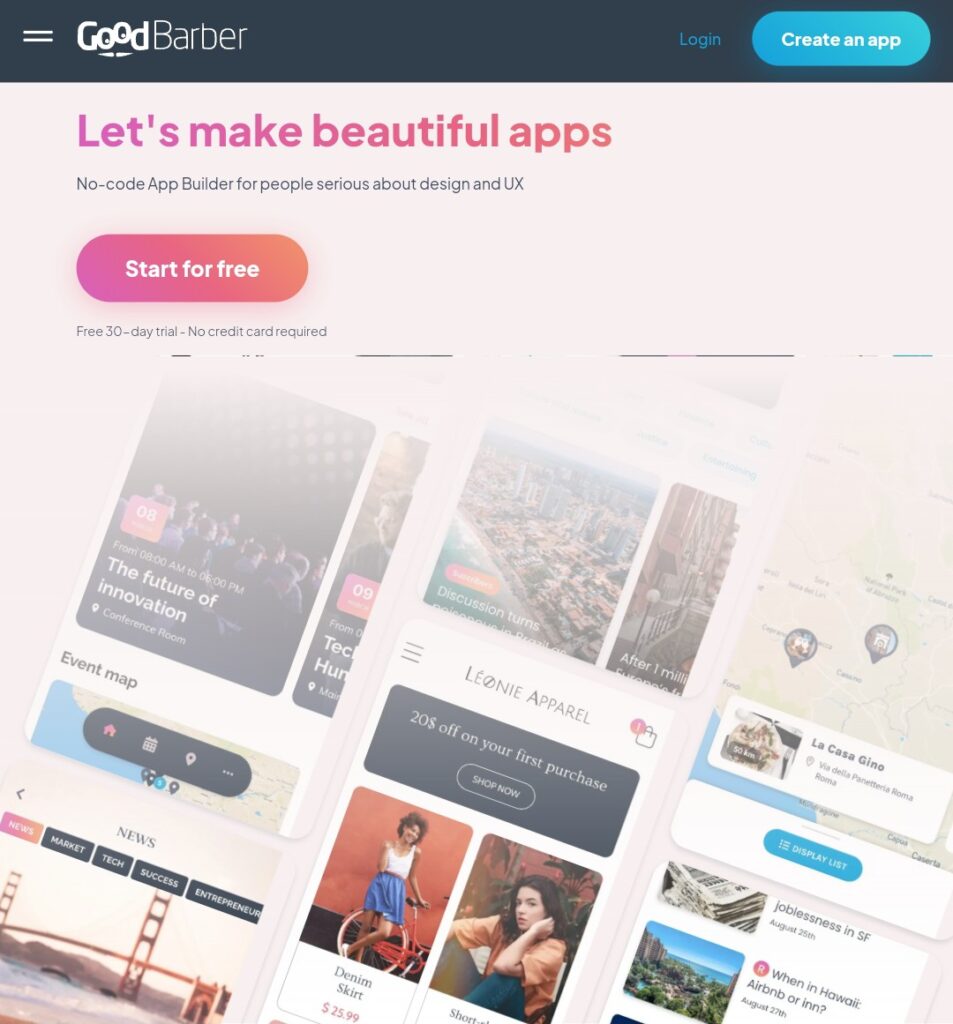
An app development platform called GoodBarber makes it easier for different types of businesses to create online and mobile applications. It’s the perfect option for brands who want their apps to look as good as they work, with a strong focus on design aesthetics.
The Reason I Choose GoodBarber:
I gave preference to platforms that served particular niches while selecting the tools for this list. I found GoodBarber’s dedication to design and its large collection of beautiful templates to be quite impressive. For entities who prioritize visual design, GoodBarber really excels, in my opinion.
Key Features & Integrations:
GoodBarber offers an extensive selection of editable templates that suit a variety of sectors and guarantee a customized user experience. To improve app operation, the platform also incorporates features like geofencing and push notifications. GoodBarber’s integration capabilities enable it to integrate with third-party tools such as Facebook, Twitter, and WordPress, thereby expanding the applications’ content and social interaction offerings.
| Pros | Cons |
| Thorough integration with widely used social media networks | Reports of occasionally delayed responses from customer service |
| Including cutting-edge functions like geofencing | Deep customization restrictions for experienced developers |
| Extensive template library with a focus on design | For newcomers, it could be a little overwhelming |
Mobincube
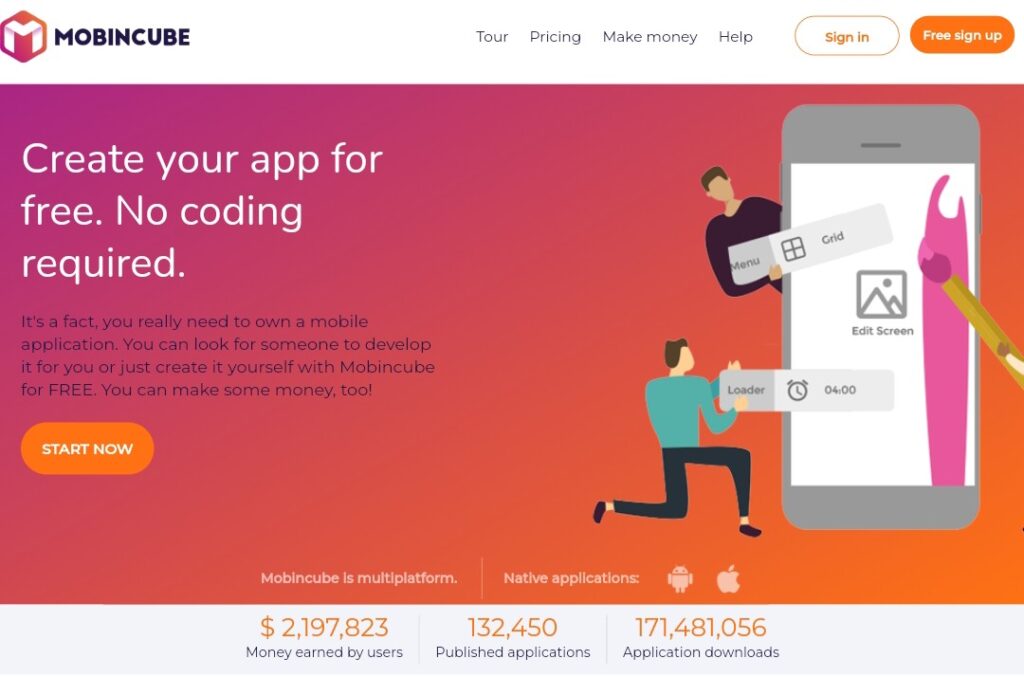
Without the need for coding knowledge, Mobincube offers a platform for creating mobile applications. Its unique benefit is that it can publish apps on several platforms, which makes it perfect for businesses who want to reach a wide range of users on different kinds of devices.
Why Mobincube was my choice:
During the tool selection process, I discovered that Mobincube provides clear benefits for individuals seeking multi-platform publishing. It was evident from evaluating and contrasting its characteristics with those of the other competitors that what sets it apart are its publishing capabilities on various platforms. Because of its multiplatform capabilities, Mobincube is my top choice for anyone looking to reach users across several platforms.
Key Features & Integrations:
With its feature-rich visual editor, Mobincube makes it possible to create captivating apps without knowing any code. Its library has a wide range of templates designed for various business requirements. By integrating with key tools for analytics, monetization, and database solutions, Mobincube offers a comprehensive environment for development and implementation.
| Pros | Cons |
| A range of templates suitable for various markets | Some advanced features are only available with higher-tier plans |
| Extensive visual editor designed with non-developers in mind | The basic plan may have limited customization options |
| Enables publishing on several platforms using a single build | For new users, the UI may appear complicated |
Adalo
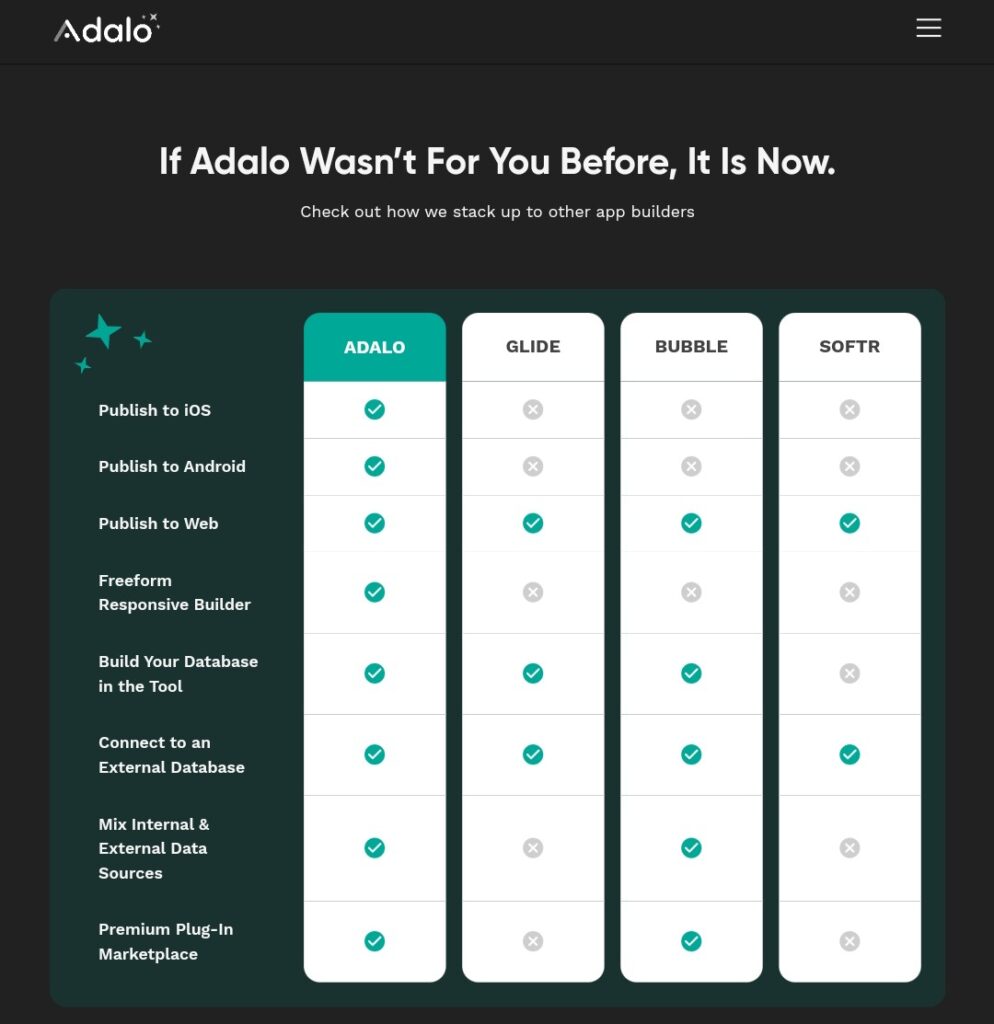
With Adalo, users may create applications without having to learn complex coding. Its unique selling point is its emphasis on making it easier for developers to create apps with captivating and dynamic user interfaces, especially for users who value interaction and experience.
The Reason I Selected Adalo:
After deciding that Adalo’s products have exceptional interactive interface design, I made my decision. After evaluating and contrasting it with other tools, I came to the conclusion that its special design tools and user-friendly drag-and-drop functionality provide greater UI interaction. Because of its focus on user-centric design, Adalo is, in my opinion, the finest option for people looking for interactive user interfaces.
Key Features & Integrations:
Adalo is well known for its user-friendly component library, which simplifies and prioritizes app modification. The drag-and-drop functionality guarantees that even non-technical individuals can create interactive user interfaces. Adalo offers a wide range of integrations, such as database administration, e-commerce, and analytics tools, guaranteeing a comprehensive app development experience.
| Pros | Cons |
| Wide range of integrations for comprehensive app development with a strong emphasis on user interaction in designs | Fewer choices for more extensive code modifications |
| Simple component library for various user interface elements | Platform performance may differ for complicated applications |
| Perhaps there will be a learning curve for complete novices |
AppSheet
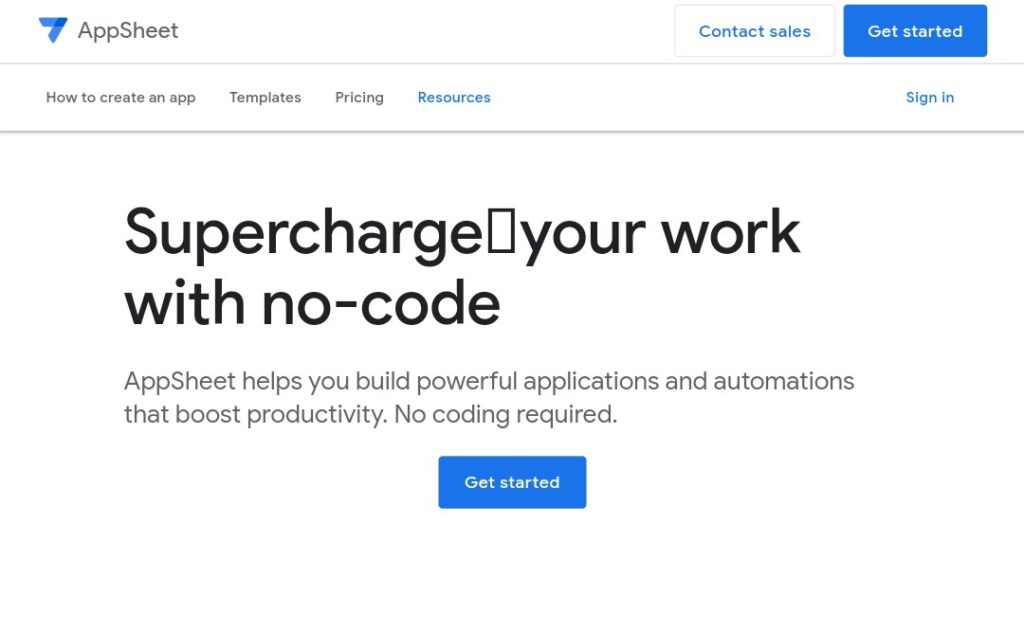
With AppSheet, users can build apps straight from spreadsheets or databases, whatever data source they want. Designed for users who wish to have a direct impact on the functionality of the app, it becomes a fundamental component of data-driven application development.
Why AppSheet was my choice:
AppSheet caught my eye when I was looking through different app builders because of its distinct method of creating applications. What impressed us the most was its capacity to transform data sources into useful apps without requiring a lot of coding. It’s, in my opinion, the best tool for anyone trying to create apps that significantly rely on pre-existing data sources.
Key Features & Integrations:
AppSheet’s strength is in converting databases and spreadsheets from programs like Google Sheets, Excel, and SQL into interactive applications. Changes in data sources are instantly reflected in the app because to its clever design. AppSheet integrates with popular cloud storage providers, which improves its capacity to extract data from a variety of sources.
| Pros | Cons |
| Platform without code that doesn’t require developers | For maximum functionality, a solid understanding of the data source is necessary |
| Current app content is ensured via real-time data syncing. Direct app creation from numerous data sources | Perhaps less customization available than on full-stack development platforms |
| Learning curve for people who don’t know anything about data structures |
OutSystems
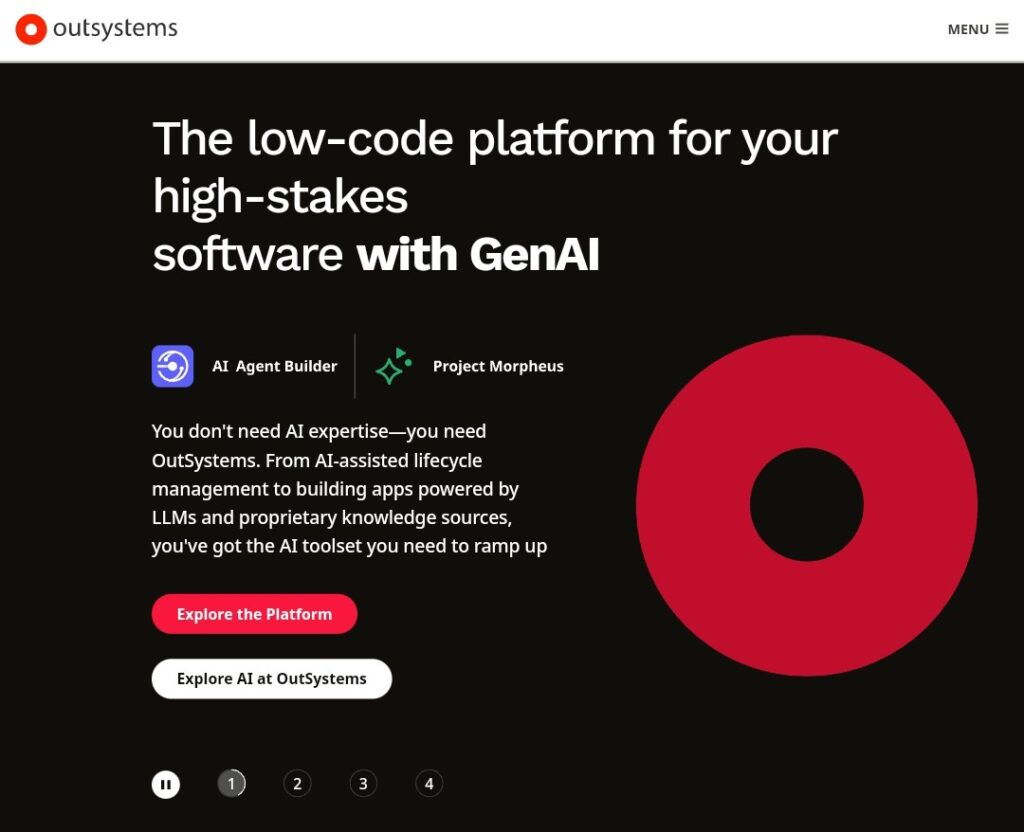
OutSystems is a state-of-the-art platform that uses drag-and-drop functionality and visual interfaces to speed up the app development cycle. It should come as no surprise that it is a top option for people looking to expedite application development and get to market sooner, given its dedication to quick deployment.
The Reason I Selected OutSystems:
After researching several platforms, I decided on OutSystems because of its ability to speed up the application development process. Its architecture was unique since it was designed with quick iterations in mind. OutSystems has established a name for itself in the field of rapid application development, making it the go-to option for people who value efficiency and speed.
Key Features & Integrations:
With OutSystems’ visual development interfaces, users can drag and drop components to build intricate workflows. Users can save time and preserve consistency between apps with its reusable components. In terms of integration, OutSystems offers flexibility and guarantees more efficient workflows by connecting with well-known databases, CRM programs, and even custom back-end systems.
| Pros | Cons |
| Numerous integrations with widely used tools | Restricted native mobile functionality in comparison to platforms with specific features |
| Provides recyclable parts to maintain uniformity | Pricing for smaller firms may be more expensive |
| A visual development helps prototype more quickly | More difficult learning curve for newcomers |
BuildFire

BuildFire gives customers the ability to create original apps while relying on a solid template base. Enticing people who seek a starting point but yet crave customisation, it seamlessly combines personal design flare with template-based development.
Why BuildFire was my choice:
I thoroughly compared BuildFire to other platforms before deciding on it, especially because of its hybrid approach to app construction. Its combination of readily available templates and extensive customization capabilities was what made it stand out. BuildFire is a platform worth considering for individuals that value a starting template but also wish to incorporate their own ideas.
Key Features & Integrations:
Not only does BuildFire offer a wide range of templates that suit different businesses, but it goes beyond that. Because each template is so adaptable, customers can fine-tune and customize it to meet their specific needs. BuildFire is flexible in terms of integration, integrating with a wide range of technologies, including CRM systems, marketing platforms, and e-commerce solutions.
| Pros | Cons |
| Extensive features for integrating third-party tools | Pricing disparities could be a barrier for initiatives funded by bootstraps |
| For users of all skill levels, the intuitive UI makes it approachable | Certain built-in features call for additional plugins |
| A wide variety of templates with extensive modification possibilities | Because of the level of customisation, it could be too much for total beginners |
AppMakr
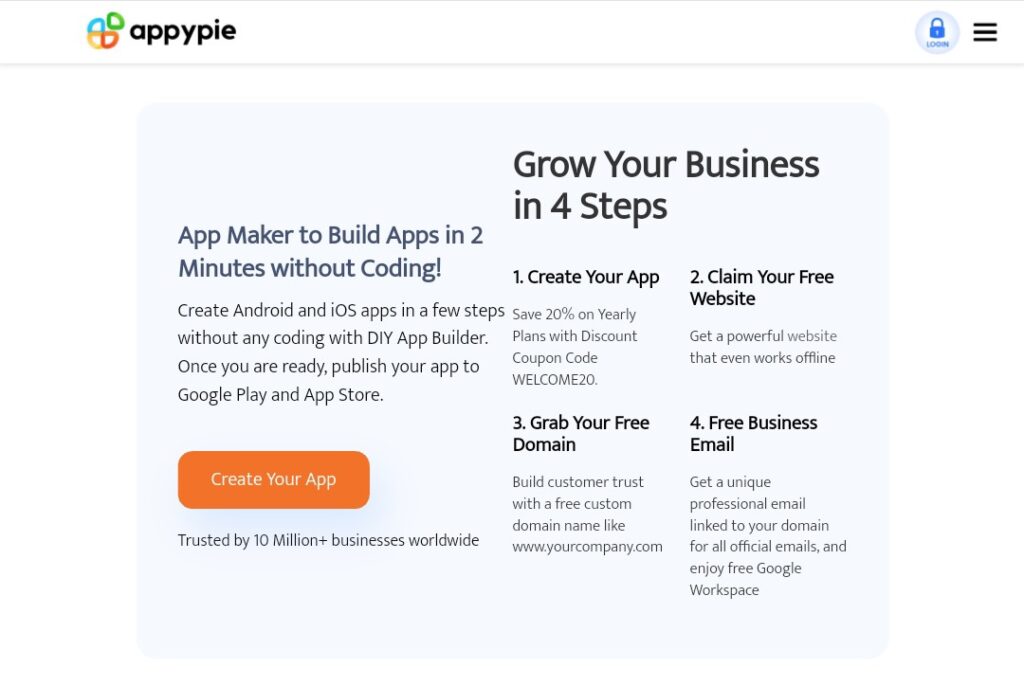
AppMakr is a platform that offers tools designed for a wide range of users with the goal of streamlining the mobile app creation process. Because of its diverse toolkit, it is especially well-suited to creating educational applications that cater to the requirements of educational institutions and instructors.
Why AppMakr was my choice:
AppMakr’s focus on educational app development drew my attention during the evaluation and comparison process of several app building tools. It includes capabilities that are specifically tailored to the transmission of instructional content, which is why I chose it for this list. It’s a great option for developing educational apps because of the focus on features that are instructive.
Key Features & Integrations:
AppMakr’s method for delivering educational information, which enables the dissemination of resources and classes, is one of its key characteristics. To improve the learning process, it also provides interactive quiz modules and facilities for student feedback. It seamlessly integrates with databases and educational platforms, making it easy for teachers to retrieve and present knowledge.
| Pros | Cons |
| Integrations that work well with widely used educational platforms | Limited alternatives for more experienced users to customize the design |
| Interactive test and quiz modules | Need regular updating to reflect changes in education |
| Customized instruments for disseminating instructional content | Perhaps less adaptable when creating non-educational apps |
2024’s Trends in Drag-and-Drop App Builders
Drag-and-drop app builders have become a keystone for democratizing app creation as the field of software development expands, allowing both developers and non-developers to create applications with visual interfaces. We can determine the paths these app builders are taking, the features that are becoming more popular, and the ones that are becoming less important by looking through product updates, press announcements, and release logs from top platforms. This analysis sheds light on how drag-and-drop technology adapts to changing user needs and technological advancements:
Drag-and-Drop App Builder Trends
- Enhanced Cross-Platform Compatibility: It is highly valued to be able to develop once and distribute across several platforms (iOS, Android, and Web) without requiring major changes. This illustrates the constant need for app development to be more efficient and to reach a wider audience.
- AI-Powered Design Assistance: AI-powered tools that make design recommendations, enhance user interfaces, or eliminate tedious work are developing quickly. This invention cuts down on the time and skill needed to produce well-designed, intuitive apps.
- Integration of Blockchain: A few drag-and-drop builders have begun to incorporate blockchain features, making it possible to create decentralized apps (DApps) without knowing any code. This unique feature satisfies the increasing curiosity about blockchain technology and its possible uses outside of the cryptocurrency space.
The Most Wanted Features and Features That Are Losing Significance
- Capabilities for Responsive Design: Advanced features for responsive design are still in great demand for tools. It is vital to guarantee that programs display and function flawlessly across all devices, given the variety of ways end consumers currently access apps.
- Real-time Preview and Testing: It’s a widely appreciated feature that lets developers observe instantaneously how changes impact the application on various platforms and devices. Iterative development and quick prototyping depend on this immediacy.
- Basic Widget-Based Components: Simple widget-based components that don’t allow you to change or expand their functionality are getting harder to find, even though they’re still valuable. More adaptable components that may be customized to meet the specific requirements of applications are what developers are searching for.
These patterns ensure that these tools continue to be at the forefront of democratizing app creation by reflecting both the present and future needs of the app development community.
A Drag-and-Drop App Builder: What Is It ?
An application builder that is a drag-and-drop platform is a software that lets users develop apps without the need for traditional coding by arranging components graphically. Entrepreneurs, designers, and startups that want to create apps without having a lot of programming experience frequently use these technologies. Companies can quickly develop, implement, and maintain apps that enhance internal processes or offer novel client experiences with the help of this kind of software.
Fast app development, customization, and device deployment are made possible by features like cross-platform compatibility, pre-built templates, and easy interfaces. The potential of these tools to democratize app development—making it possible and accessible for users of all skill levels to realize their digital ideas—is what gives them their overall value.
Drag-and-Drop App Builder’s Features
The following are some of the most crucial characteristics of drag-and-drop app builders to look for:
- The development of apps is made easier by the intuitive user interface. Because it guarantees that users of all technical skill levels can navigate and utilize the tool efficiently to realize their app ideas, a simple and well-organized interface is crucial.
- Vast Selection of Pre-built Templates: These templates provide a foundation for different kinds of applications. Having a large collection of templates at one’s disposal is crucial since it enables users to jump right into projects and make customizations without having to start from scratch, serving a variety of sectors and use cases.
- Large Component Library: This library offers the application’s fundamental components. A large component library is essential because it allows users to add a great deal of functionality, from simple features to complex ones, to their apps without having to write any code.
- Apps with responsive design capabilities will appear fantastic on all types of devices. The ability to create apps that automatically adapt to the screen size and orientation of different devices—from smartphones to tablets to desktop computers—is a critical component of responsive design skills.
- Cross-platform compatibility: This enables the use of software across several OS platforms. Cross-platform compatibility is crucial because it allows developers to publish their apps on many platforms—iOS, Android, and the web—and reach a larger audience without having to make different versions of the software.
- Real-time preview and testing: With this feature, users can see and work with their app as it’s being developed. An iterative design process requires real-time preview and testing so that users can quickly evaluate and improve the functionality and user experience of their app.
- Integration Options: These let apps establish connections with databases and other services. Integration options are important because they let users add additional data and features to their apps, such payment processors, social media platforms, and cloud storage, which increases the apps’ functionality and capability.
- More sophisticated customisation is possible with custom code injection. Although drag-and-drop builders are designed for non-programmers, users who want to add special features or connectors not offered by the standard components should have the ability to inject custom code.
- Options for Scalability: These make sure apps can expand to meet customer demand. Scalability features are crucial because they guarantee that the application can accommodate growing numbers of users and data over time, facilitating the expansion of the company or audience without necessitating a total rebuild.
- Support and Documentation: This offers tools and direction to users. In order to ensure that users can optimize the potential of their app projects, excellent support and thorough documentation are crucial for assisting users in overcoming obstacles and learning how to use the tool more efficiently.
All of these characteristics work together to guarantee that drag-and-drop app builders are both widely available and strong and adaptable enough to produce apps of a high caliber. These solutions, which prioritize functionality, user experience, and support, enable companies and people to create and realize their digital ideas more quickly and easily.
Benefits of Using Drop-and-Drop App Builders
The process of developing apps has been transformed by drag-and-drop app builders, opening up the process to a greater number of individuals and businesses. These technologies, which make the process of creating apps simpler, have become indispensable for companies that want to develop fast without requiring a deep understanding of coding. The following are the top five advantages of using drag-and-drop app builders:
- Decreased Development Time: The app development cycle is greatly shortened with this software. Organizations may accelerate the launch of their digital goods and quickly adapt to user input and market demands by enabling users to graphically design apps.
- Reduced Costs: A large development staff is not necessary when using drag-and-drop app builders. The lighter financial load is especially advantageous to small firms and startups, allowing for the development of apps on a lower budget without sacrificing quality.
- Ease of Use: These technologies’ user-friendly interfaces democratize app development. This makes it easier for people without professional programming experience to create apps, which encourages innovation in a variety of economic sectors.
- Flexibility and Scalability: These platforms provide a high degree of customisation thanks to their vast libraries of pre-built elements and templates. As their business expands, users can begin with a basic app and add more features as needed, keeping the app current with changing user needs and business plans.
- Cross-Platform Compatibility: Develop once and implement globally. This feature makes it easier to reach a wider audience by sparing customers from the complications and extra expenses involved in creating distinct versions of an app for several operating systems.
With drag-and-drop app builders, users and organizations may interact with app development in a way that is more efficient, economical, and intuitive. They enable a wide spectrum of people and companies to engage in the digital economy in addition to streamlining the app building process. These technologies offer a range of advantages that are in line with the strategic objectives of contemporary enterprises, whether they are being used for democratizing technology, cutting overhead expenses, or rapid prototyping.
Frequently Asked Questions (FAQs)
Do you still have inquiries about drag-and-drop app creators? We have solutions!
What an App Builders Do ?
Without the need for code development, anyone may design and distribute mobile apps using an app builder, which is an online software tool. Using a straightforward visual editor, it’s a turnkey solution for anyone without technical experience to create mobile apps.
Are App Builders Easy To Use ?
Both programmers and non-technical individuals can benefit greatly from the no-code functionality, which frees up time and energy to concentrate on the design, functionality, and other elements of creating an app.
Do These App Builders Come With a Hidden Price ?
Even while the initial expenses are usually obvious, there can be further charges for more data storage, more integrations, or app store publishing. It is imperative that you review the terms and look for any further costs.
If I’m Not Happy, Can I Change Plans or Obtain a Refund ?
The majority of platforms let customers move between plans, and if you upgrade in the middle of a payment cycle, the fee is usually prorated. That being said, refund policies differ throughout sites. Before committing to a plan, it is advisable to review their return policy and take advantage of any trial periods.
Conclusion
We’ve made every effort to offer a thorough summary of the best drag and drop app builders out there. But the tech world is big and changing all the time. Please let us know about any tools you think should be on this list or if you have firsthand experience with any that really stuck out.
We appreciate your helpful ideas and comments, which enable us to maintain our guide up to date and applicable for all of our readers. Together, let’s improve this resource even further!
